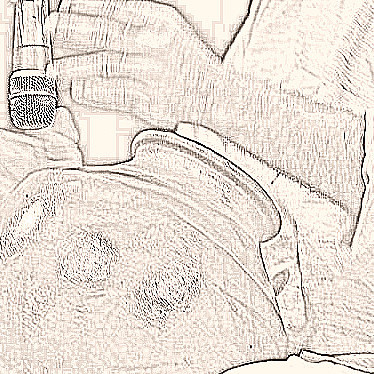by Lalitha Ravichandran
 "It is not the strongest of the species or the most intelligent that survives. It is the one that is the most adaptable to change." - Charles Darwin
"It is not the strongest of the species or the most intelligent that survives. It is the one that is the most adaptable to change." - Charles DarwinDarwin’s quote about life forms applies equally to art forms as well.
You could walk into Theatre de la Ville in Paris, France and listen to a Western Classical piece by Mozart, Bach or Beethoven and be assured that neither the instruments used to play the compositions nor the compositions themselves have undergone significant changes since they were notated by the great Music Composers some two hundred and fifty years ago. In fact all the artists have their notation books spread out in front of them to which their eyes are riveted.
In contrast, saunter into the hallowed halls of Music Academy, Chennai, India on a balmy December afternoon and listen to a recital of some composition of Thyagaraja, Dikshitar or Syama Sastri and the music you hear will in all likelihood have at least some differences from what you heard last time let alone from what it was a couple of centuries ago.
Carnatic Music is a living abstract art form. Innovations are many and are not spear headed by any institution but are brought about by practitioners of the art according to their creative imagination and have subsequently come to be accepted and followed as the model. Changes in format, content and presentation continue to occur and this article is an attempt to highlight some of the salient changes.
Changes which are good will withstand the test of time – frivolous and whimsical changes just for the sake of change or to boost one’s ego will wither away. This growth and evolution of Carnatic Music augurs well for its future and is a harbinger of greater innovations to come.
Take for instance the current day concert format- Ariyakudi Ramanuja Iyengar is credited with creating this format. Prior to Ariyakudi, carnatic music concerts would have a single main composition that would be elaborated for hours and a couple of smaller compositions. Although the current concert format tilts the balance in favor of variety of ragas within a time frame it allows room for plenty for manodharmam (individual creativity) and each performer can choose to experiment on the ratios of the kalpita and manodharma sangeetham (learned and creative music) of his or her rendition to fit the circumstances and to cater to the audience tastes. The raaga alapana which is the creation of an abstract musical ambience in which the composition floats gives full scope to this exercise. In recent times, several performers are continuing to experiment with the concert format and present thematic concerts which are gaining in popularity.
Content
Some Fifty years ago a concert musician’s repertoire consisted predominantly of the compositions of the trinity. That is not the case anymore – Many a brilliant composer’s works are seeing the light of the day thanks to efforts of some Carnatic musicians who have taken it upon themselves to popularize them. Sri. Semmangudi is credited with showcasing Swathi Tirunal compositions and Smt. M L Vasanthakumari with bringing to light several Purandara Daasa devarnaamaa. Now we have a Sri. Ravikiran and Smt. Aruna Sayeeram unearthing, polishing and presenting saptaratnas and other compositions of Oothukadu Venkata Kavi, a brilliant pre trinity composer whose corpus of work is being understood and appreciated not only for its melodic and rhythmic beauty but also for the lyrical and poetic beauty. Sri Annamacharya is another pre trinity composer whose works are being set to music by Nedanuri Krishnamurthi and propagated by TTD (Tirumala Tirupathi Devasthanams).
Dozens of Tamil composers of the twentieth century like Bharathi, Papanasam Sivan, Ambujam Krishna, Thanjavur Sankara Iyer etc have enriched the carnatic music repertoire of today’s concerts.
In terms of the compositions of the trinity themselves, there are different schools and the patantharam (version) is different amongst the schools. Sangathis (melodic improvisation of a line of lyric) not in the original composition are supposed to have crept into some compositions. Absence of notated music and a reliance on aural assimilation and oral transmission have led to this situation. Carnatic music with its microtones and gamakams is difficult to notate in rigid contours and sing there from. But that has not prevented people from making or using notations as a basic tool. However most of the practitioners and students teach and learn carnatic music relying entirely on the oral tradition.
Bhakti (devotion to a higher Being) was the predominant theme of the trinity compositions (with various Ishta devathas). However many a composition with themes of desa-bhakti (patriotism), courage, and world-peace are found in the compositions of modern vaggeyakaras. Shringaaram (love) has made its way into the concert platform in the form of Jayadevar’s Ashtapadis or a padam or javali, which originally belonged to the Sadir or dance repertoire.
 Presentation
PresentationThe violin, a western classical music instrument has been wonderfully adapted to play carnatic music. Baluswami Dikshithar (Brother of Muthuswamy Dikshithar) and Vadivelu of Tanjore Quartet are largely responsible for this innovation. Prior to the advent of violin as an accompanying instrument, carnatic music recitals would have veena as an accompaniment. The trend continues and today you can hear carnatic music played on the following western classical music instruments such as mandolin, saxophone, clarinet, keyboard, guitar and piano.
Traditional carnatic music instruments have undergone quite a few changes to enable them to be transported – so for instance the tambura, veena and mridangam can now be disassembled into two parts and put back together.
Technology has found its way onto the concert stage – be it in the usage of amplification for the concert, contact mikes for the veena, electronic sruthi box for the maintenance of sruti (drone) as opposed to the tambura, talometer to assist instrumentalists in maintaining taalam (rhythm).
Many new ragaas (scales) are being discovered and songs being set in them –Mahathi by Balamuralikrishna comes to mind. Similarly several varnams and thillanas composed by violin legend Lalgudi Jayaraman are frequently rendered in concerts.
Carnatic Music stands tall among the genres of World Classical Music in terms of its remarkable adaptability to the changing times, while continuing to retain its soul. Changes which are good will withstand the test of time – frivolous and whimsical changes just for the sake of change or to boost one’s ego will wither away. This growth and evolution of Carnatic Music augurs well for its future and is a harbinger of greater innovations to come.

